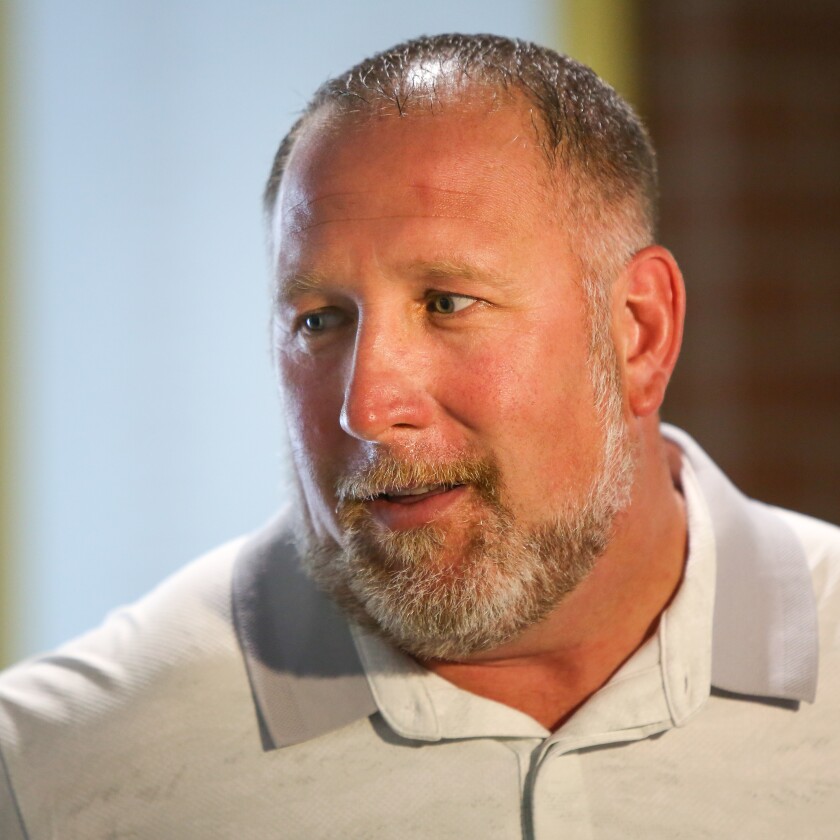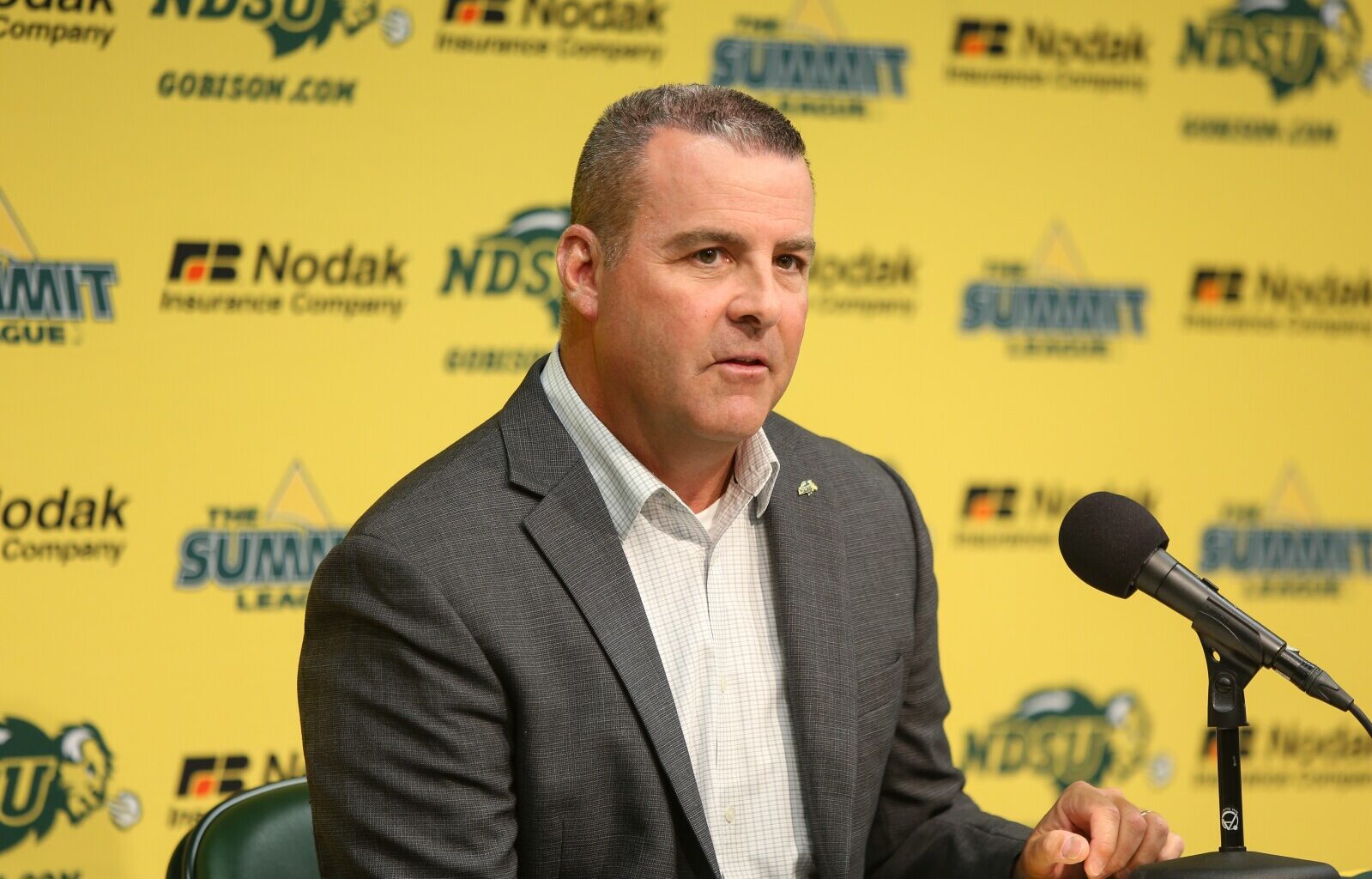FARGO — The revolving door known as opting in or out to the NCAA vs. House settlement decision finally stopped moving at the Sanford Health Athletic Complex on Monday. North Dakota State is all in.
Athletic director Matt Larsen on Monday cited two main reasons: cuts to rosters being phased over five years instead of effective immediately and the ability to take NIL in-house as opposed to third-party entities like The Green and The Gold Collective.
Recent legislation is putting limitations and more scrutiny on collectives. Larsen said all third-party deals with collectives now need a valid business purpose in the promotion or endorsement of goods and services.
In other words, the days of pay-for-play in college athletics are slated to end, or at least tamper down.
At NDSU, Team Makers booster club will oversee the collective and will be renamed the Green and Gold Fund. Payments to student-athletes will now come from the Bison athletic department.
“It’s not going away, the mechanism is now going from the collective to us,” Larsen said.
Furthermore, donations to NDSU’s in-house collective fund can be tax deductible, something that wasn’t the case with The Green and The Gold Collective. That entity was started by NDSU graduate Jay Bartley, who in 2-1/2 years along with Bison alum Curt Wittich grew the fund to difference-making levels.
For instance, the collective helped retain football players the last couple of years when players at other FCS schools left at a heavy pace.
“They stepped up two years ago when nobody else wanted to,” Larsen said. “We wouldn’t be in the position to opt in if it wasn’t for their work. It’s not a new concept to fans and donors. We’ve seen it in action. And it took awhile for people to get on board, it was a new concept and it was different.”
Now it’s an adjusted concept, with Bartley saying he’s looking forward to working with the Bison athletic department to make a successful transition to the Green and Gold Fund. He likes that it’s essentially taking the Green and Gold name from the collective.
“Very excited he wants to continue a lot of the ideas that Curt and I and the collective put together,” Bartley said. “From a financial standpoint, becoming tax deductible is a big deal to a lot of people. That’s a question we heard a lot.”
In almost three years, the NDSU collective grew to 700 active members, with donors having the option to pay monthly.
“It’s really important, they care a bunch,” said Bison head football coach Tim Polasek. “That can start to produce some funds so I think getting as many of those people on board to transition into the Green and Golf Fund would be magnificent.”
Polasek said he would like to continue to provide collective members opportunities to attend practice or other functions.

NDSU head football coach, Tim Polasek talks with media after a press conference on Monday, June 30, 2025, at the Sanford Health Athletic Complex.
Chris Flynn / The Forum
The opt-in decision reversed a course Larsen was taking when asked in January, with the biggest reason team rosters not being immediately capped at a certain number. Football, for instance, will have five years to get to 105 rather than having it sliced to that number immediately.
If NDSU didn’t opt in now, the grandfathering option wouldn’t be available in future years.
“For the longest time we were out,” Larsen said. “Our rosters were really important to us. Providing opportunities was really important and at the time when you compared us to FCS or mid-major programs, we were already financially supporting our student-athletes way better than a lot of schools, regardless of whether they were going to opt in or not.”
Cutting student-athletes could hurt the general enrollment at NDSU, with Larsen estimating if rosters were immediately slashed that would have affected 50 to 60 participants. On the flipside, the Bison could if they wanted to offer 105 football scholarships (the roster cap) although it remains to be seen if they have the means. Or if they even want to.
The maximum allowable 63 scholarships for FCS football will be no longer, although leagues like NDSU’s Missouri Valley Football Conference can set their own maximum. There is precedent of the Bison administration quickly adding full rides; when NDSU made the Division I transition starting in 2004, the school went from the maximum of 36 in Division II to the FCS 63 as quickly as it could.
Under terms of the House v. NCAA settlement, a suit initially brought by former Arizona State swimmer Grant House in 2020, additional scholarships and payments made available to student-athletes above the pre-settlement NCAA maximums will count toward each institution’s benefits cap, which is $20.5 million for the 2025-26 season. Any number of rostered athletes may be on scholarship, up to the roster limit.
It’s highly doubtful NDSU will in the foreseeable future dole out $20.5 million to athletes. Each head coach in consultation with their sports supervisor will be in charge of disbursement
“I’m still a firm believer that at least in the foreseeable future we’re not going to be a program that is going to pay a kid a half million dollars,” Larsen said. “That’s not who we are and I don’t know if that’s who we want to be. We have a ton of flexibility up to $20.5 million in year one, now we’re probably not going to get to $20.5 million in year one, but we have a ton of flexibility there. We’d like to get to a point where we have a solid base with the Green and Gold Fund where programs that need it will have a budget they can utilize on an annual basis.”

Jeff Kolpack, the son of a reporter and an English teacher, and the brother of a reporter, worked at the Jamestown Sun, Bismarck Tribune and since 1990 The Forum, where he’s covered North Dakota State athletics since 1995. He has covered all 10 of NDSU’s Division I FCS national football titles and has written four books: “Horns Up,” “North Dakota Tough,” “Covid Kids” and “They Caught Them Sleeping: How Dot Reinvented the Pretzel.” He is also the radio host of “The Golf Show with Jeff Kolpack” April through August.
